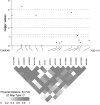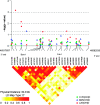Vitamin D-related genes, serum vitamin D concentrations and prostate cancer risk
- PMID: 19255064
- PMCID: PMC2675652
- DOI: 10.1093/carcin/bgp055
Vitamin D-related genes, serum vitamin D concentrations and prostate cancer risk
Abstract
We systematically investigated the association of 48 SNPS in four vitamin D metabolizing genes [CYP27A1, GC, CYP27B1 and CYP24A1] with serum 25-hydroxyvitamin D [25(OH)D] and 1,25-dihydroxyvitamin D [1,25(OH)(2)D] levels and the association of these SNPS and an additional 164 SNPS in eight downstream mediators of vitamin D signaling [VDR, RXRA, RXRB, PPAR, NCOA1, NCOA2, NCOA3 and SMAD3] with prostate cancer risk in the 749 incident prostate cancer cases and 781 controls of the Prostate, Lung, Colorectal and Ovarian Cancer Screening Trial. 25(OH)D (all cases and controls) and 1,25(OH)(2)D (a subset of 150 controls) levels were measured by radioimmunoassay and SNP data were genotyped as part of a genome-wide scan. Among investigated SNPS, only four tag SNPS in GC, the major serum 25(OH)D carrier, were associated with 25(OH)D levels; no SNPS were associated with 1,25(OH)(2)D levels. None of the 212 SNPS examined were associated with cancer risk overall. Among men in the lowest tertile of serum 25(OH)D (<48.9 nmol/l), however, prostate cancer risk was related to tag SNPS in or near the 3' untranslated region (UTR) of VDR, with the strongest association for rs11574143 [odds ratio (95% confidence interval) for risk allele carriers versus wild-type: 2.49 (1.51-4.11), P = 0.0007]; the genotype associations were null among men in tertile 2 and tertile 3. Results from the most comprehensive evaluation of serum vitamin D and its related genes to date suggest that tag SNPS in the 3' UTR of VDR may be associated with risk of prostate cancer in men with low vitamin D status.
Figures




References
-
- Peehl DM, et al. Antiproliferative effects of 1,25-dihydroxyvitamin D3 on primary cultures of human prostatic cells. Cancer Res. 1994;54:805–810. - PubMed
-
- Oades GM, et al. Vitamin D receptor-dependent antitumour effects of 1,25-dihydroxyvitamin D3 and two synthetic analogues in three in vivo models of prostate cancer. BJU Int. 2002;90:607–616. - PubMed
-
- Corder EH, et al. Vitamin D and prostate cancer: a prediagnostic study with stored sera. Cancer Epidemiol. Biomarkers Prev. 1993;2:467–472. - PubMed
-
- Tuohimaa P, et al. Both high and low levels of blood vitamin D are associated with a higher prostate cancer risk: a longitudinal, nested case-control study in the Nordic countries. Int. J. Cancer. 2004;108:104–108. - PubMed
-
- Gann PH, et al. Circulating vitamin D metabolites in relation to subsequent development of prostate cancer. Cancer Epidemiol. Biomarkers Prev. 1996;5:121–126. - PubMed
Publication types
MeSH terms
Substances
Grants and funding
LinkOut - more resources
Full Text Sources
Medical
Miscellaneous

